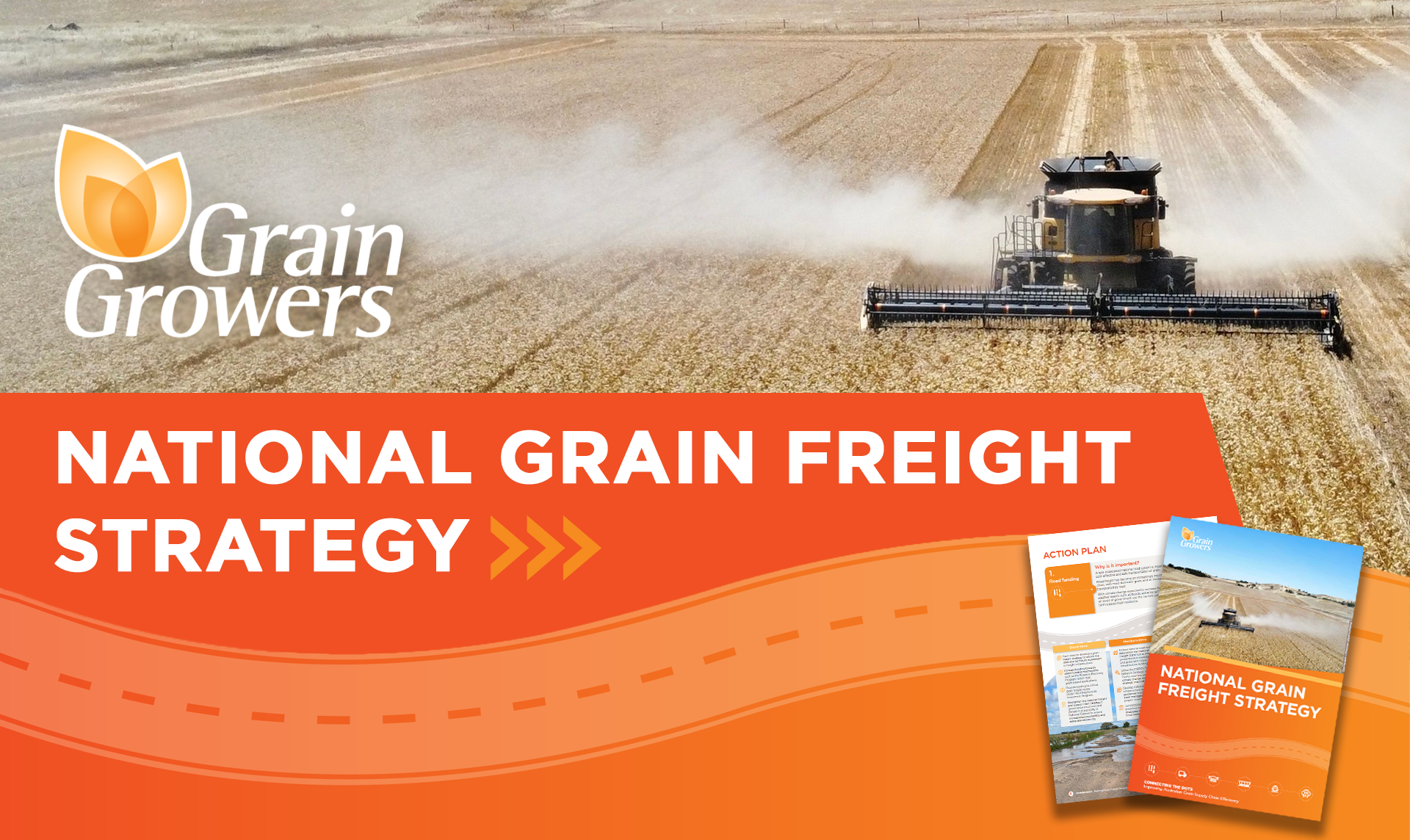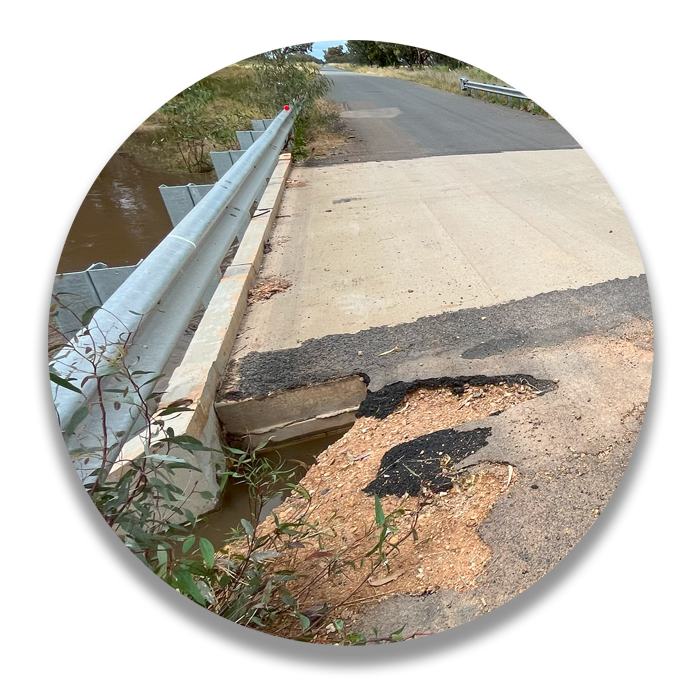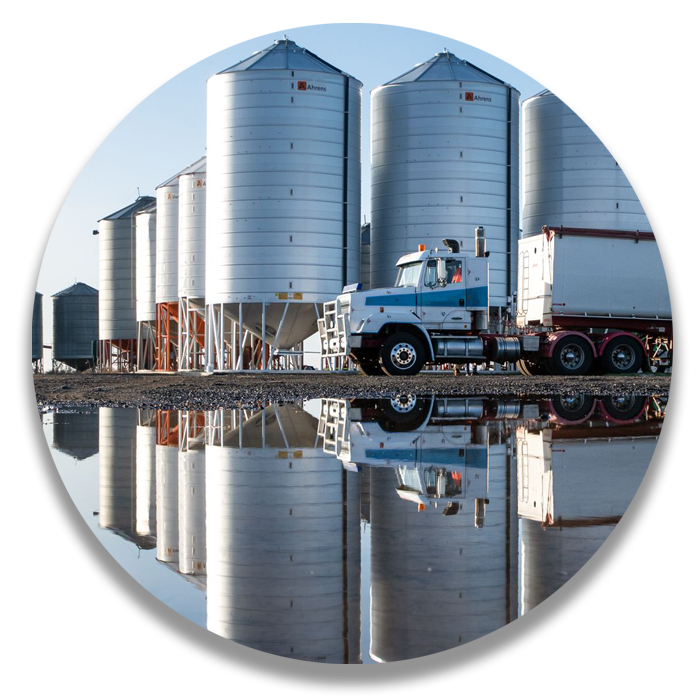GrainGrowers National Grain Freight Strategy

Australia's grain freight challenge
The Australian grain freight supply chain is characterised by diverse, complex and multi-directional freight journeys, often across multiple modes of transport.
From paddocks across regional Australia, grain travels either by road, rail or a combination of both, to port for export or to domestic markets such as flour and feed mills, malthouses, food manufacturers and livestock feedlots According to CSIRO TranSIT modelling, transport costs the grain industry $2.1 billion per annum, representing the single largest cost in Australian grain production.
The past three record harvests have underscored capacity constraints within the network. Australian grain faces increasingly strong international competition in key export markets as a globally traded commodity.
The road map
Reducing supply chain costs presents a key opportunity to ensure Australian grain remains globally competitive and to deliver savings for Australian growers.
GrainGrowers' National Grain Freight Strategy sets out short, medium and long-term priorities to ensure the continuing strength of the grain industry.
Building on the findings of the Connecting the Dots report, and incorporating consultation with over 40 industry stakeholders, the Strategy provides a practical road map for government to ensure Australia’s global competitiveness.

Australia’s Priority Grain Freight Routes
GrainGrowers has released Australia’s Priority Grain Freight Routes: Critical Infrastructure, Bottlenecks, and Strategic Investment Requirements.
The report highlights the freight routes most important to moving millions of tonnes of grain each year and identifies where targeted upgrades are needed to reduce costs, improve safety, and keep Australian growers globally competitive.
It provides a detailed breakdown of grain freight movements by state, demonstrating the complexity of Australia’s grain supply chain and the distinct patterns between regions. Until now, much of this information has been limited in its public availability. This report brings it together in one place, offering new insights into where investment will deliver the greatest benefits.

Key Objectives

Encourage competition and new supply chain entrants

Increase scalable capacity within the supply chain

Streamline and harmonise regulation

Build supply chain resilience

Support new technologies and innovation

Enhance freight sustainability

ACTION PLAN

Road Funding
Road Funding
Why is it important?
A well-maintained national road system is imperative for the efficient,
cost-effective and safe transportation of grain. Road freight has become an increasingly important element of the grain supply chain, with most domestic grain, and an increasing proportion of export grain, transported by road.
With climate change expected to increase the frequency and intensity of
weather events such as floods, extreme temperatures and bushfires, it is vital
all levels of government use the current period to strengthen Australia’s long term supply chain resilience.

- Each state to develop a grain freight strategy to inform the direction for future investment in freight infrastructure.
- Increase funding towards direct funding mechanisms such as the Roads to Recovery Program rather than grant-based applications.
- Provide funding to critical grain freight routes under the Infrastructure Investment Program.
- Strengthen the National Freight and Supply Chain Strategy’s governance structures and elevate it as a priority in National Cabinet to ensure
increased accountability and adequate resourcing.

- Embed national road resilience data within the National Freight Data Hub to increase jurisdictional knowledge and assist with future infrastructure funding.
- Utilise the CSIRO’s Transport Network Strategic Investment Tool to examine projected climate change impacts on strategic road network routes.
- Develop national road infrastructure resilience guidelines to inform
asset management and project investment. - Jurisdictions to implement proactive road maintenance strategies with a core focus on flood resilience.

- Reform road funding, re-balancing funding across metropolitan and regional
councils, based on network size and economic impact. - Jurisdictions to develop road maps for transitioning existing infrastructure to meet the needs of autonomous vehicles.

Road Regulation
Road Regulation
Why is it important?
Improved regulation has the potential to improve the safety and productivity of grain freight.
Existing road regulation is hampering the adoption of High Productivity Freight Vehicles (HPFVs) despite the overwhelming potential benefits for safety, efficiency and lowering carbon emissions.
In addition to carrying higher volumes and reducing freight costs, using Performance Based Standard (PBS) vehicles minimises damage to road infrastructure and improves road safety with 46% fewer major crashes per kilometre travelled than conventional heavy vehicles.
Although Heavy Vehicle National Law was intended to encourage innovation, productivity and efficiency in the road transport sector, in practice, the adoption of HPFVs especially through the PBS scheme in Australia is often constrained by poor regulation and complex and lengthy permit requirements.

- Increased collaboration between jurisdictions to ensure greater streamlining of HPFVs regulations.
- All jurisdictions should explore mechanisms for increasing safety and reducing red tape for HPFVs including crossing rail lines.
- Increased shared resources for local councils to facilitate road access decisions.

- Streamline HPFVs compliance and administration requirements (such as
infrastructure assessments and road access permits) to remove barriers for smaller operators and accommodate the unique requirements of agricultural freight. - Implement a national road access system to support road managers to provide access decisions more efficiently.

- Conduct targeted regional trials to ensure future autonomous vehicle technologies and regulatory reform is fit-for-purpose for Australian agriculture

Bridges
Bridges
Why is it important?
Although there has been an increase in gazetted High Productivity Freight Vehicles (HPFV) access, the practical ability of HPFVs to operate continues to be impeded by ageing bridge infrastructure throughout the network.
Much of Australia’s regional bridge infrastructure was built over 70 years ago and is nearing the end of its useful life, but rural and regional road managers are often unable to afford the cost of replacing bridges.
Instead, many councils are forced to implement bridge load limits to protect assets, inhibiting productivity by restricting the total weight a heavy vehicle can carry over the bridge, resulting in the use of smaller and less efficient heavy vehicle combinations to transport grain.
Ensuring road infrastructure is sufficient to carry HPFVs is essential for improving supply chain efficiency for the grain industry and other industries reliant on road freight.

- Identify and fund bridge upgrades on key high volume grain freight routes with the objective of enabling significantly higher ‘whole-of-route’ freight capacity, while limiting capital requirements.
- Targeted funding for crossborder bridges to increase load capacity and dimensions to facilitate interstate freight movements.

- Targeted funding for regional local councils to conduct bridge assessments on ageing local bridge infrastructure.
- Consolidate bridge structure data between jurisdictions including the location, condition rating, bridge type, date of construction, date of last inspection and height clearance into a single database.
- Develop consistent bridge assessment formulae across jurisdictions.

- Commit long term funding to gradually improve the weight restrictions on bridges across grain producing areas to enable continued efficiency improvements.

Rail
Rail
Why is it important?
Rail is critical for the efficient transportation of grain over long distances from in-country growing regions to port.
Increasing the amount of grain freight on rail, where possible, presents a viable, existing way to substantially reduce carbon emissions. According to the Australian Rail Association, rail freight produces 16 times less carbon pollution than road freight per tonne kilometre travelled, valued at 1c per tonne kilometre.
One of the key challenges facing rail freight is that Australia has highly localised rail networks with significant variations between states, undermining the interoperability of the network. For instance, across Australia there are currently 3 separate gauges and 8 Rail Infrastructure Managers.
This lack of interoperability significantly reduces rail freight efficiency, creating extensive operational complexity that negatively impacts reliability and cycle time efficiency. This increases costs, which are ultimately borne by grain growers who receive a lower price for grain at the farm gate.

- Provide targeted funding to upgrade the rail network within critical freight corridors.
- Harmonisation of rolling stock access agreements across Rail Infrastructure Managers and streamline approvals to facilitate adoption of new technologies.
- Conduct an audit of existing infrastructure standards
and identify opportunities for standardisation and network expansion. - Provide co-funding for industry to upgrade rail sidings and loading capacity to reduce train turnaround times.

- Improve metropolitan rail network access for freight trains on shared freight/passenger lines.
- Jurisdictions to explore grants or leasing programs for operators on broad gauge lines to access new rolling stocks.
- Jurisdictions to implement proactive rail maintenance programs with a key focus on flood resilience.
- Align train control and signalling technology on the eastern seaboard.
Formalise mandatory common standards for train components between jurisdictions. - Consolidate rail freight data held by government agencies and stakeholders into a single database.

- Jurisdictions to identify priority grain freight routes for standardisation.
- Harmonise safe working rules and systems.

Ports
Ports
Why is it important?
As an export-orientated industry, a well-functioning port system is especially critical for Australia’s grain industry that relies on the nation’s ports and shipping networks to transport grain to overseas markets.
Australia’s ports and related landside logistic chains face major challenges from growth in trade.
Port and maritime inefficiencies have had a profoundly detrimental impact on grain exports, with spiralling costs and delays. These issues will only further intensify as Australia’s ports face challenges from increasing trade.

- Introduce a nationally coordinated approach to port regulation that ensures greater consistency and coordination between jurisdictions, including container terminal charges.
- The Australian Government to monitor port productivity.

- All levels of government incorporate the National Urban Freight Planning Principles in land use decision-making to improve planning for freight across Australian ports.
- Ensure appropriate and effective regulatory arrangements are
adopted during port privatisation processes. - Targeted investment to address last mile access to critical infrastructure connecting the port.

- Repeal Part X of the Competition and Consumer Act to increase competition between shipping lines.

Freight Decarbonisation
Freight Decarbonisation
Why is it important?
Decarbonisation will represent a fundamental shift to Australian grain freight and the broader freight industry. The Australian Government has legislated an emissions reduction target of 43% by 2030 and net zero emissions by 2050 under the Climate Change Act 2022.
As a hard to abate industry, this will require a nationally coordinated, strategic and staged transition with collaboration across the supply chain.
The commercialisation of low emission road and rail technologies is still in its infancy and therefore targeted government support will be required to enable the development of viable low emission pathways for grain freight.

- Implement a National Transport and Infrastructure Net Zero Roadmap and Action Plan that provides a nationally consistent approach to accelerate decarbonisation.
- Include decarbonisation as a goal of the National Freight and Supply Chain Strategy.
- Develop a National Modal Shift Scheme to incentivise increasing the amount of grain freight on rail, where possible.
- Explore opportunities for the domestic production of canola-based biofuels that can be used in existing combustion engines to reduce emissions.

- Develop a national agriculture-specific low emission vehicle roadmap and strategy.
- Targeted funding through the Driving the Nation Fund to ensure adequate access to charging infrastructure in regional Australia.
- Grants and resourcing for small businesses to adopt new low emission technologies.

- Fund renewable fuel hubs in regional areas for agricultural freight.
Remaining competitive on a global scale
Despite having a proximity advantage to Indonesia, where sea transit times from Australia are 50-75% less than transit times from Canadian and Ukrainian ports, Australia is experiencing heightened competition.
CASE STUDY: Ukrainian grain
Prior to the Russia-Ukraine conflict, Ukrainian grain production costs were approximately AUD$70 less per tonne than in Australia. Similarly, the total cost of producing a tonne of grain, including delivering it to port and loading it onto a ship in Russia was approximately AUD$124 less than in Australia.
While Russia and Ukraine’s wheat exports are reduced at the present due to the conflict, export volumes are expected to normalise over the medium to long-term.
Australia must have an efficient grain supply chain to be competitive on a delivered-cost basis.
Listen to the podcast!
Australia needs increased supply chain efficiency to remain globally competitive and reduce grower costs. Join GrainGrowers for this paddock-to-port look at the grains supply chain and hear directly from growers and industry guests about the key challenges, what’s driving these issues and what can be done.

Grain freight and supply chains
Freight costs account for 30% of the price of grain at port. Australia's global competitiveness is limited by the cost of transporting grain and efficient supply chains are critical for future industry success. GrainGrowers is driving an agenda to improve access to and efficiency of the grain supply chain.

READ MORE: Connecting the Dots
